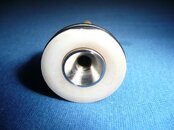Zung
Contributor
Dear Board,
I just dug out another SP MK 20. This one has the preferred composite piston, but there's a little bit missing on the plastic crown: see the attached pic. There's no loose bits inside the reg.
Q.: is this by design or has it broken off? Any wild guess: will it still seal? Is it worth putting it back for a try or should I replace it right away?
Thanks for any comments.
Zung
I just dug out another SP MK 20. This one has the preferred composite piston, but there's a little bit missing on the plastic crown: see the attached pic. There's no loose bits inside the reg.
Q.: is this by design or has it broken off? Any wild guess: will it still seal? Is it worth putting it back for a try or should I replace it right away?
Thanks for any comments.
Zung





